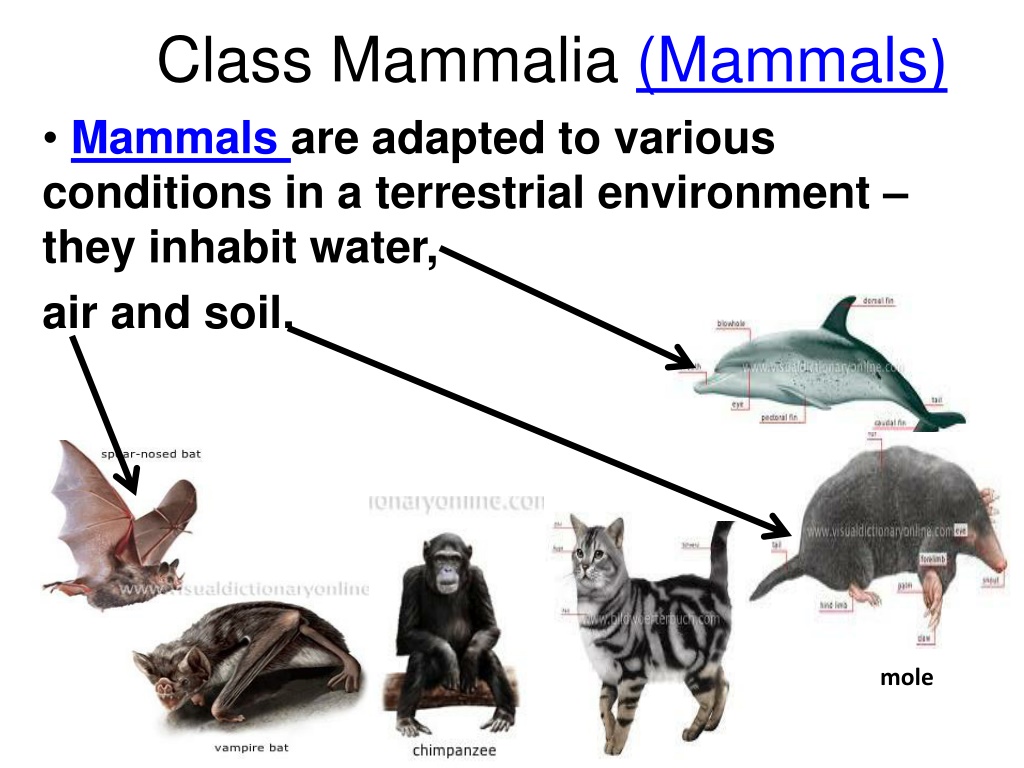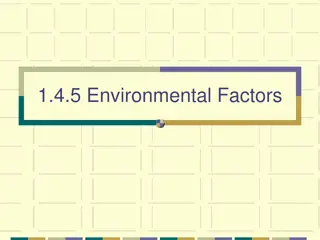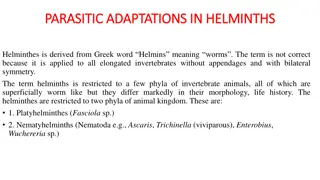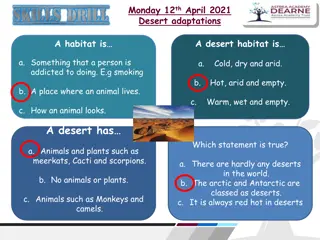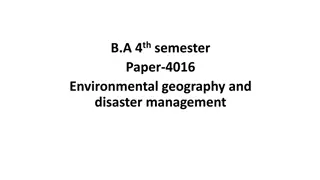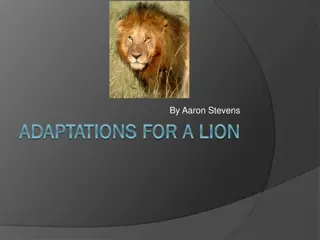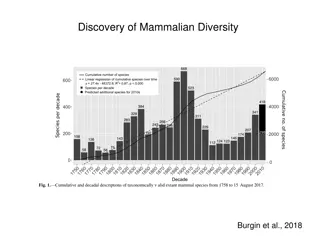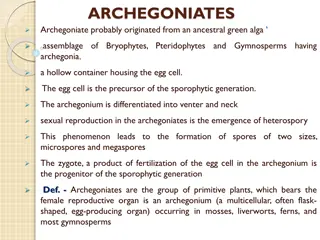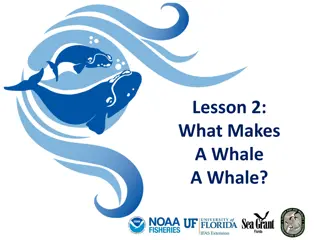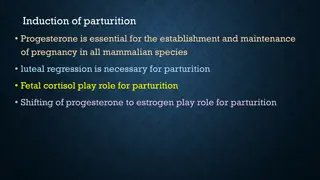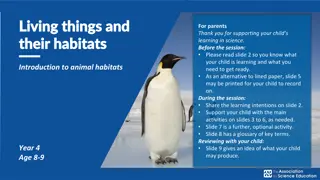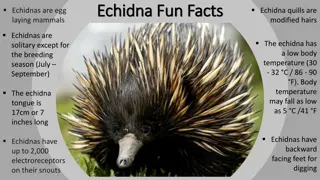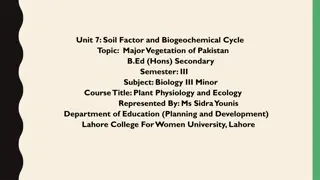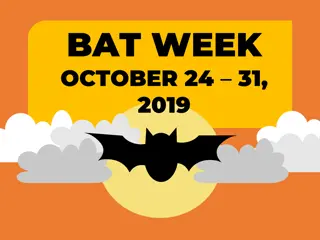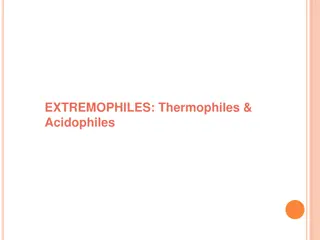Adaptations and Characteristics of Mammals in Terrestrial Environments
Mammals are well adapted to various terrestrial conditions, inhabiting water, air, and soil. They maintain a stable body temperature, have fur for temperature regulation and protection, and unique limbs for different modes of movement. The distinguishing features of mammals include fur, specialized glands, and different teeth for various types of feeding. Internally, mammals have complex pulmonary and circulatory systems, a well-developed brain with sensory organs, and unique ear structures for hearing.
Download Presentation

Please find below an Image/Link to download the presentation.
The content on the website is provided AS IS for your information and personal use only. It may not be sold, licensed, or shared on other websites without obtaining consent from the author. Download presentation by click this link. If you encounter any issues during the download, it is possible that the publisher has removed the file from their server.
E N D
Presentation Transcript
Class Mammalia (Mammals) Mammals are adapted to various conditions in a terrestrial environment they inhabit water, air and soil. mole
Their constant body temperature 36-37 allows them to be independent of the ambient environment and they are spread from the equator to the poles. The fur (hair), that is covering the body, allow them mainly for maintaining internal body temperature and is providing protection from insect bites. In temperate climatic zones, mammals change their fur in spring and autumn. Summer fur is sparse and short, while in winter it is thick and long.
Distinguishing features The body of mammals is covered with fur (hair). The skin is rich in glands: sebaceous, sweat, smell and mammary. They have mammary glands that produce milk to feed their babies.
Different limbs are characteristic, related to the way of locomotion. In running, flying, swimming mammals the limbs have different sizes and shapes. SEAL
http://www1.znam.bg/resources/1/2835943093.jpg They have different teeth for cutting (incisors), tearing (canines) and grinding (molars). Mammals feed with various types of food.
Internal structure Pulmonary system The lung consist of pulmonary sacs (alveoli) that increase the total surface area of gas exchange.
The heart consists of four chambers. Mammals are two types of circulation pulmonary and systemic. There is a muscular septum between the chest and abdominal cavity diaphragm which takes part in the breathing process.
The telencephalon is the largest part of the brain and covers the other parts. The cerebral cortex is folded and well developed. The sensory organs are also well developed. The eyes are protected by upper and lower eyelids. Mammals are the outer ear and ear pinna. ear cats have a highly developed sense of hearing.
The reproductive system consists of ovaries (in females) and testes (in males). The mammals have mating rituals and they care of babies. Fertilisation is internal. Most mammals are viviparous. They feed their babies with milk rich in proteins, sugars, vitamins, minerals.
classifications Monotremes (egg layers) platypus and echidna 1subclass 2 subclass Marsupials Pouch Placentals womb Placentals 3 subclass
Monotremes The most primitive mammals . They reproduce with eggs. The eggs are big, rich in nutrients and covered which a hard shell. They hatch in nests or in special skin sacs on the female body. They have a cloaca a joint opening for the digestive, excretory and reproductive systems. Adults have horny plates on their jaws. Their body temperature is low and varies greatly.
Monotremes are mammals that inhabit Australia and islands. There are five extant species, which are grouped into two families Platypuses and Echidnas. The platypus lives in holes near sea coast, river or likes. The echidna body is covered in sharp spines. It is short and strong claws. It uses them to dig in the ground in order to find food (termites, ants and worms) and to dig its nest.
http://visual.merriam-webster.com/images/animal-kingdom/marsupial-mammals/kangaroo/morphology-kangaroo.jpghttp://visual.merriam-webster.com/images/animal-kingdom/marsupial-mammals/kangaroo/morphology-kangaroo.jpg Marsupials These animals are called marsupials because their females have a skin pouch (from Latin marsupium a pouch) on the ventral part of their body. Their body temperature is higher than of Monotremes
The pregnancy period is short and the newborn is underdeveloped blind and helpless. The female usually has a ventral pouch in which the embryo develops after birth. In the pouch, the newborn attached itself to the nipples. The female injects the milk into newborn s mouth by contracting the muscles on the mammary glands.
examples of marsupials Today, marsupials live on the Australian continents, New Zealand , South America and North America. There is only one type of opossum.
Marsupials included about 250 extant species. tasmanian devil koala Grey kangaroo
Placental mammals Placental mammals are the most numerous group of extant mammals. They inhabit the whole planet except for Antarctica. They have different habitats and developed various life forms on land, under the ground, in water, on trees and in the air.
Distinguishing feature of placental mammals The pregnancy period is long and the newborn offspring are full developed. In females, during the pregnancy, a special organ is formed a placenta in uterus(womb), through which the embryo is nourished. This organ gives the name of groups. The mammary glands have nipples, by which breast milk is delivered to newborn offspring. Placental mammals are grouped into seventeen orders.
Order Rodents Rodents are the most numerous group. Its representatives are small animals which have long and sharp incisors that grow throughout their whole life. Among its representatives are squirrels, mice, hamsters, dormice, rats, et.
examples of rodents examples of rodents [1] beaver
INSECTIVOROUS MAMMALS Vertebrates (about 370 species) with four limbs and a body almost entirely covered with hairs and sometimes barbs; they feed on insects. Moles , hedgehog , shrews belong to order Insectivorous. insectivorous mammals Hedgehog
Orders insectivores Insectivores comprise the most primitive placental mammals. The Etruscan shrew is the smallest mammal species.
FLYING MAMMAL Very widespread groups, some 900 species of bats live mainly in colonies, in trees or in caves. The Bats have wings with thin a membrane of skin , connecting the fingers of the front and hind limbs, the body and the tail. There are 35 bat species in Bulgaria. All of them are protected both in Bulgaria and the rest of Europe.
Carnivorous mammals (about 270 species) that have strong canines and sharp molars adapted for eating flesh. CARNIVOROUS MAMMALS http://www1.znam.bg/resources/1/2422524442.jpg Polar bear tiger Black bear
examples of carnivorous mammals Brock hyena
Carnivorous leopard
http://www1.znam.bg/resources/1/1223048915.jpg hyena fox lion tiger
UNGULATE MAMMALS are even-toed and odd-toed ungulates pigs Even-toed ungulates. They comprises herbivorous large mammals, which have only two toes on each limb. These toes are covered with horny structures hoofs. Their way of moving are running. Pigs, hippopotamuses, deer, antelopes, goats, giraffes, etc. belong within this order. hippopotamus
. Even - toed ungulates bison
examples of ungulate mammals There are many species of ungulate mammals; some are wild, some are domesticated. Giraffe elk mouflon http://www1.znam.bg/resources/1/2832956187.jpg . elephant antelopes
Odd-toed Ungulates Odd-toed Ungulates comprises herbivorous mammals whose limbs adapted for running Tapirs, rhinoceros, horses etc. belong within this order. In them, only the middle toe is developed. It is covered with a horny substance to form a hoof. http://www1.znam.bg/resources/1/2973894506.jpg
Odd-toed Ungulates
PRIMATE MAMMALS Vertebrates (about 200 species) with hands and feet, with five digits ending in a nail; they live mainly in trees and can stand erect. tamarin examples of primates Many species are protected, especially because destruction of their habitat
Order Primates includes prosimians, simians(apes) and hominids. The pregnancy lasts 7 to 9 months. The Hominids apes are orangutans, chimpanzees and gorillas. examples of primates [2]
MARINE MAMMALS Carnivorous aquatic vertebrates (about 116 species) with limbs evolved into fins, skin that is smooth or covered in short hairs, and sometimes a dorsal fin. humpback whale northern right whale beluga whale sperm whale killer whale
Order cetaceans includes the only mammals adapted to life in water dolphins, porpoises and whales. They look more like fish. The fore limbs evolved into flippers, while the hind ones are rudimentary. dolphin Porpoise
Marine mammals: many actively hunted species (more than 110 out of 116) are protected or are subject to hunting restrictions. Marine mammals are orders: fin-footed mammals and cetaceans. Seals and walruses are among fin-footed. Their body is elongated, they have short webbed legs, adapted for swimming. walrus
Many placental mammals are endangered animals. The Bulgarian Red Data Book includes 19 species marten, marbled polecat, brown bear, otter, wild cat, monk seal, all bats, etc.
